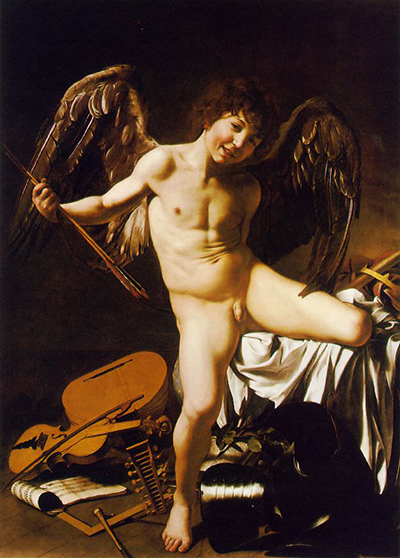The painting Amor Victorious is also called Amor Vincit Omnia (Latin for Love Conquers All") and Victorious Cupid. This piece of art was created by Caravaggio between 1602 and 1603, according to Artemisia Gentileschi's reference, an Italian painter who lent a pair of wings to Caravaggio, that his model used while posing.
Amor Victorious depicts Cupid, the Roman god of attraction, desire and love, whose name in Latin is Amor. Cupid is the son of Venus (goddess of prosperity, almost equivalent to the Greek goddess of love, Aphrodite) and Mars (the god of war). However, different from others, Caravaggio preferred to show a mischievous Cupid, instead of an angelic and naive one. The boy in the painting has an insolent smile while holding some of his arrows, maybe demonstrating his power over humans. But certainly, an aspect that really calls the attention's viewers are the different objects below Cupid: musical instruments, an armour, a golden crown, a globe and mathematical tools (square and compass).
This detail is frequently interpreted as a way to demonstrate that love conquers all, just like Virgil's quote: "Love conquers all things, so we too shall yield to love." Basically, Caravaggio is showing that human reasoning, efforts, intelligence, power and talents are no match for love. And about the armour on the ground, it's possible to interpret that when talking about love, people have no defences. One signature of Caravaggio that can be identified in the Amor Victorious is the nude. Influenced by the Michelangelo's style, Caravaggio painted a boy in an extremely erotic and realistic way. The boy is completely naked and instead of beautiful muscles, Caravaggio brings fat all over Cupid's body.
Painting boys in a realistic way and with a strong sexual appealing is also one of Caravaggio's marks. Just like Michelangelo, the Baroque painter used to portray the beauty of nude males, especially young men. And of course, his usual tenebrism technique is used to highlight the curves, textures and colours of Cupid's body. The position of the boy has been associated with the statue of Michangelo called Victory. Amor Victorious was a work of Caravaggio commissioned by an Italian banker and art collector called Marchese Vincenzo Giustiniani, who made some expositions of the painting and it was a huge success at the time. Nowadays, the 5-feet canvas is a property of the Staatliche Museum, in Berlin and can be seen by the public.




